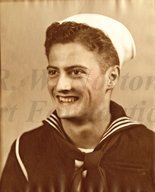
|

|
|
|
|
Bob, as he was called, was born in Vicksburg, Mississippi, the second of five sons of Isador and Flora Hardin Rosenzweig. His father arrived in America at Ellis Island at age two with his widowed mother from Romania. Bob grew up in Tallulah, Louisiana, where his father ran a grocery and variety store, along with a slaughter house. "During the Depression he lost most of what he had," Bob recalls. "We became a rather poor family at that time. We never did think of it as being poor, but looking back on it we were quite poor." He recalls climbing trees as a youngster, swimming in nearby lakes, fishing in the bayou behind his house, playing baseball in vacant lots, and hunting squirrels and ducks. The family moved to Lake Providence where his father worked in his brother's grocery store. Bob played trumpet in the high school band, and graduated in 1941. He went to Bossier City soon after Pearl Harbor and worked as a messenger boy at Barksdale Field. There he taught himself to type. Along with one of the female officer workers, Josephine Cross, he was transferred to Selman Field in Monroe. "She was just a kid, too," he recalls. "She became chief clerk and I was assistant chief clerk." Soon the Monroe office grew to fourteen secretaries. "Under me and Josephine!" he exclaims. "A seventeen-year-old kid with no education at all and I had secretaries working for me who had business training." He was asked to open an office as chief clerk at a new base in Texas. Instead, he chose to join the U.S. Navy in May of 1943. After boot camp in San Diego he was sent to Aviation Radio School in Memphis, and gunnery school in Hollywood, Florida. In Fort Lauderdale, he was assigned to a TBM Avenger Bomber, a torpedo plane, with a crew of pilot, gunner, and radioman. Instead of torpedoes, his aircraft usually was armed with bombs ranging from 100 to 2,000 pounds. By the winter of 1945, after more training, especially in carrier take-offs and landings, he was sent to Pearl Harbor, where his plane was assigned to the aircraft carrier USS Bunker Hill (CV-17). As radioman, Bob's main job was operating the radar, watching through a rubber mask a scope that he remembers as about eight inches wide by twelve inches long. On February 16, 1945 he flew his first combat mission (they called them "strikes"), dropping incendiary bombs on the Nakajima Aircraft Ota Factory near Tokyo. "Fire, nothing but fire. That's all I saw," he says in remembering that raid. "Everything was burning. The whole world was burning up down there." Bob flew air strikes in the campaigns for Iwo Jima and Okinawa. He also helped sink the massive Japanese battleship, Yamato on April 7, 1945. "We had three planes attacking the bow and three attacking the mid-ship, and we were in the third crew attacking the fantail," he recalls. He was on the receiving end of an air attack a month later on May 11, when kamikazes hit the Bunker Hill. Earlier, a friend, Dick McDermott, had taken his duty in the Ready Room. Bob was just rising from a nap when he heard two "whomps." He was able to make his way up through fire, smoke, and the dead and wounded to reach the heavily damaged flight deck. He saw what he thought was part of the body of a kamikaze pilot. "I saw this thing sticking out of his top pocket and started looking at it, and he had pictures in there of a Japanese woman and some little Japanese kids and some yens--some money," he recalls. "About that time an arm reached over my shoulder and took it out of my hand. I don't know who that was. Maybe an intelligence officer." He would not learn until decades later that McDermott was killed in the Ready Room. Bob was back in the States by June 2, 1945. He was sent back to the Naval Air Technical Training Center in Memphis. "The word was that I was being prepared to go back to Fort Lauderdale for more training, and then back overseas again," he recalls. "But September came and the big bombs came." He had earned two Distinguished Flying Crosses and five Air Medals, and completed twenty-six missions by the time he was discharged on October 9, 1945. Bob returned to school. Hurrying to finish a bachelor's degree in pre-dentistry, he took classes at Northeast Junior College of Louisiana State University (now University of Louisiana at Monroe), LSU in Baton Rouge, and Tulane University and H. Sophie Newcomb College Memorial Institute, both in New Orleans. After earning his degree he entered the Senior Military Dental Program in which he was commissioned as a second lieutenant in the U.S. Army upon graduation. Bob married Beverly Molony in December of 1951. (They would have four children and nine grandchildren.) He served 18 months before resigning his commission, moving to Shreveport, and starting a practice. Bob retired from his practice in 1990. He earned his real estate license and worked in that business for eight years. |


